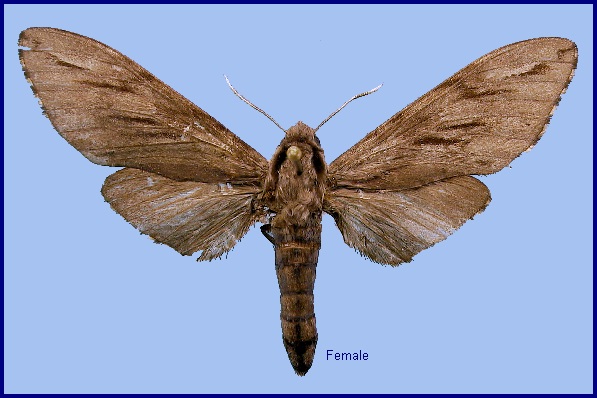
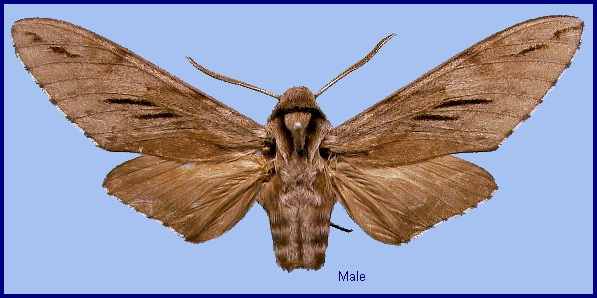
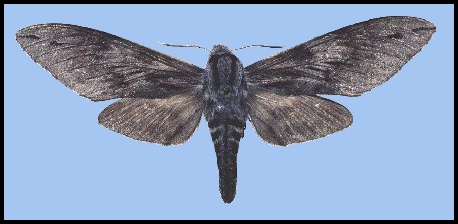
Hyloicus oberthueri Rothschild & Jordan, 1903, Novit. zool. 9 (suppl.): 119 (key), 149. Type locality: China, [Yunnan,] Tsé-kou [Yanmen, 28°04'N 98°54'E].
Synonym. Sphinx oberthueri (Rothschild & Jordan, 1903).
Synonym. Sphinx jordani Mell, 1922, Dt. ent. Z. 1922: 113. Type locality: China, W. Yunnan.
Synonym. Sphinx thailandica Inoue, 1991.
Note. The details for Hyloicus jordani are: [Syntypes: 2 male] China: West Yunnan (R. Mell) [?MNHU]. Mell, 1922, Beitr. Fauna Sinica 2 (Biol. Syst. sudchin. Sphingiden): 57, gave the following data for two males: 1 male China: Yunnan, road from Yunnan-fu [Kunming] to Tali-fu [Dali], near Schi-tze [= Jize?], bred from full-grown larva, 25.vii.; and 1 male China: Yunnan, road from Yunnan-fu [Kunming] to Tali-fu [Dali], near Dschautschou [= Zhaozhou?], bred from fully-grown larva, end viii. He also referred to a female captured near Dschautschou [= Zhaozhou?], 9.viii. However, this specimen cannot be a syntype as the original description referred only to males. These specimens were the only ones known to Mell at that time. No type material for this taxon has been found in CMNH. The specimen labelled 'type' appears to be the female referred to be Mell (1922); it is labelled 'Tali', with the data '8.8.14'. There is a female labelled 'paratype' and '18 Gaithain' in MNHU; this is not a type.
Forewing much more elongate than in Hyloicus caligineus, Hyloicus brunnescens and Hyloicus pinastri. Colour similar to Hyloicus caligineus caligineus, but the fringe as sharply marked brown and white as in Hyloicus pinastri. Hindwing with stalk of veins Sc and M1 about half as long as crossvein m1-m2. Abdomen with narrow lateral white bands. Body underside paler grey than upperside. Legs similar to those of Hyloicus caligineus: tibiae almost without spines; spurs short, the long apical one of the hindtibia about one third the length of first hindtarsal segment, which is itself as long as segments 2-5.
The forewing uppersides vary, being very lightly marked in some, while others bear heavy dark streaks and thick transverse lines similar to those found in Hyloicus pinastri. Many, but not all, individuals are also more grey when freshly emerged, but this fades to light brown after a few days as per the examples below.
In the male genitalia, uncus elongate, more slender than in Hyloicus caligineus, slightly dilated before apex, the edge somewhat notched, shortly hooked at apex, the ventral side deeply concave. Gnathos longer than in Hyloicus caligineus and Hyloicus pinastri, sinuate, the lobes slender, subconical, somewhat curved apically. Valve similar to that of Hyloicus caligineus, more rounded than that of Hyloicus pinastri. Harpe characteristic, with two short distal processes separated by a rounded sinus, the upper process with one or more marginal teeth, the lower subconical, pointed, slightly curved, narrower and shorter than the upper. Phallus produced into a short process that is rounded apically and slightly curved.
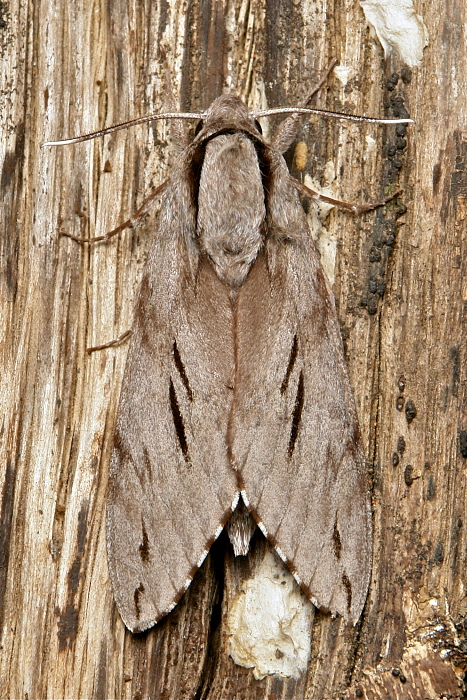
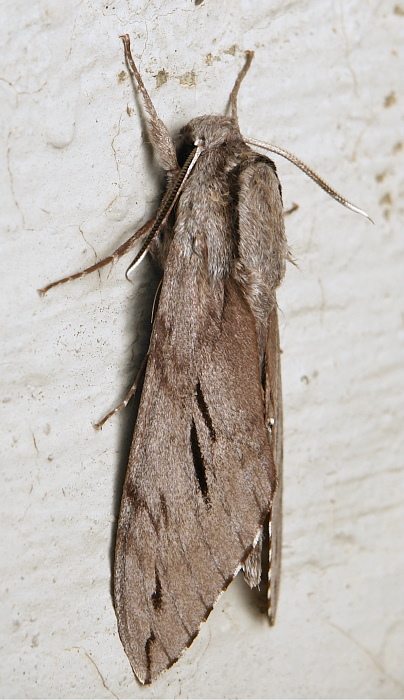
China: 10-19.iii (Simao/Pu'er, Yunnan); iv (Jiangkoushan, Shanxi); 7.v (Xishuangbanna, Yunnan); 18-22.v (Jinggu Yizhi); 23.v (Lijiang, Yunnan); vi (Songzishanding, Yunnan; Simao/Pu'er, Yunnan); vii (Dianchang Shan, Yunnan); 9.vii (Lijiang, Yunnan); 22-25.vii (Huili, Sichuan); viii (Goligong Shan, Yunnan); 1.viii (Taiyue Shan, Shanxi); 3.viii (Xichang, Sichuan); 8.viii (Dali, Yunnan); 9.viii (Zhaozhou, Yunnan); 24.viii (Xishan, Kunming, Yunnan); ix (Xunyang, Shaanxi; Dali, Yunnan).
OVUM:
LARVA: Full-fed 70--75mm. Similar to the larva of Hyloicus caligineus caligineus Butler, 1877 from Japan, but with the green paler and more yellowish.
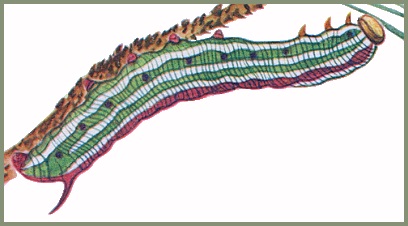
PUPA:
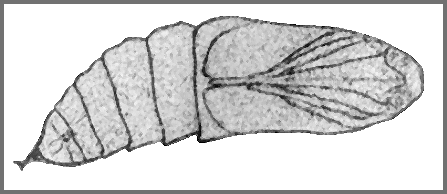
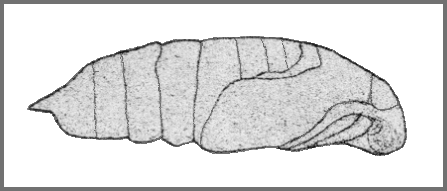
Larval hostplants. Recorded in Yunnan (as Hyloicus jordani) on Pinus massoniana (Mell, 1922b).
Unknown.
China: Shanxi (Taiyue Shan, 2000m); Shaanxi (Jiangkou, Liuba County, 1600m); Sichuan (Xichang; Huili); Yunnan (Simao/Pu'er; Yanmen; Dianchang Shan; Lijiang, 2000m; Xishuangbanna, 650m; Gaoligong Shan, 1500-2000m; Xishan; Kunming; Dali; Jinggu Yizhi, 900-1700m; Songzishanding, 2500m; Zhaozhou; Jize; Deqing/Dêqên; Dali; Yongde County, west of Lincang); ?Xizang/Tibet (Mutu, Namjagbarwa region, 850m).
Originally thought to be confined to southwestern China. The records from the Mienshan (= Taiyue Shan) (Danner et al., 1998) extends considerably northeastward the known range of this species.
With the discovery of Hyloicus centrosinaria (Kitching & Jin, 1998) in Xizang/Tibet (Thierry Vaglia, pers. comm. 2007), and the description of Hyloicus bhutana (Brechlin, 2015), from Bhutan, and Hyloicus brunnescens (Mell, 1922), from Yunnan, it is possible that the specimens recorded from that area by Wang (1988) are not Hyloicus oberthueri but one of these other species.
Central and southwestern China south to northern Thailand (Inoue et al., [1996]), and west across Myanmar/Burma to Manipur, Nagaland and Arunachal Pradesh (Tenga Valley), India (Jatishwor Irungbam & Fric, 2021), and Bhutan (Irungbam & Irungbam, 2019).
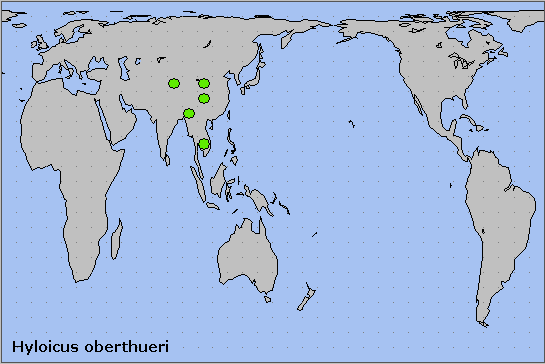
Holarctic; eastern Palaearctic region. Pleistocene refuge: Monocentric -- Yunnan refugium.
 Return to Sphingidae of the Eastern Palaearctic species list
Return to Sphingidae of the Eastern Palaearctic species list